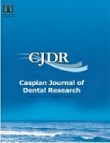Effect of diode laser and light-emitting diode (LED) activated bleaching with 35% hydrogen peroxide on microleakage of class-V composite restorations: An in vitro study
Residual oxygen-free radicals of bleaching agents before composite restorations can increase microleakage in enamel and dentin margins, and also various bleaching techniques are being developed using light sources. The present study was conducted to compare the effect of diode laser bleaching and LED activated bleaching on the microleakage of composite restorations.
This in-vitro study was conducted on 84 extracted human premolars in three groups: In group one, class-V cavities were prepared and the teeth (n=12) were restored with composite ten days after bleaching with 35% hydrogen peroxide with no activator. In groups two and three (n=36 each), the teeth were bleached with a Diode laser activator and LED, respectively. Thereafter, each group was divided into three subgroups (n=12), cavities were prepared and restored with composite three, five, and ten days after bleaching. Digital photographs were used to assess microleakage in the enamel and dentin margins. Data were analyzed using Friedman and Wilcoxon Signed Ranks tests (p<0.05).
The lowest amount of microleakage in the enamel margin pertained to the diode laser ten-day subgroup (0.17±0.38) and the diode laser ten-day subgroup in the dentin margin (0.50±1.03). Also, the highest amount of microleakage in the LED group was in the three-day subgroup of the dentin margin (2.78±0.42). Five-day subgroup of diode laser-activated bleaching had a lower amount of microleakage compared to the control group (P=0.042).
It may be concluded that diode laser-activated bleaching with 35% hydrogen peroxide has a better effect on reducing microleakage with an interval of five to ten days, compared to the control and LED activated bleaching group.
- حق عضویت دریافتی صرف حمایت از نشریات عضو و نگهداری، تکمیل و توسعه مگیران میشود.
- پرداخت حق اشتراک و دانلود مقالات اجازه بازنشر آن در سایر رسانههای چاپی و دیجیتال را به کاربر نمیدهد.


